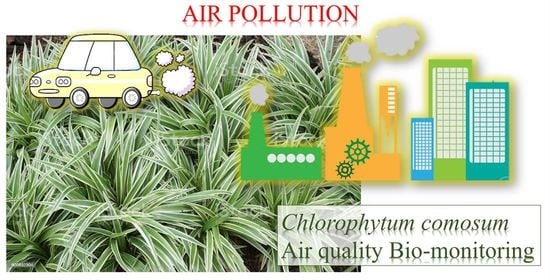Chlorophytum comosum: A Bio-Indicator for Assessing the Accumulation of Heavy Metals Present in The Aerosol Particulate Matter (PM)
Abstract
1. Introduction
2. Materials and Methods
3. Results
4. Discussion
5. Conclusions
Author Contributions
Funding
Informed Consent Statement
Data Availability Statement
Acknowledgments
Conflicts of Interest
References
- Bozzetti, C.; Daellenbach, K.R.; Hueglin, C.; Fermo, P.; Sciare, J.; Kasper-Giebl, A.; Mazar, Y.; Abbaszade, G.; El Kazzi, M.; Gonzalez, R.; et al. Size-Resolved Identification, Characterization, and Quantification of Primary Biological Organic Aerosol at a European Rural Site. Environ. Sci. Technol. 2016, 50, 3425–3434. [Google Scholar] [CrossRef] [PubMed]
- Atzei, D.; Fantauzzi, M.; Rossi, A.; Fermo, P.; Piazzalunga, A.; Valli, G.; Vecchi, R. Surface chemical characterization of PM 10 samples by XPS. Appl. Surf. Sci. 2014, 307, 120–128. [Google Scholar] [CrossRef]
- Moroni, B.; Castellini, S.; Crocchianti, S.; Piazzalunga, A.; Fermo, P.; Scardazza, F.; Cappelletti, D. Ground-based measurements of long-range transported aerosol at the rural regional background site of Monte Martano (Central Italy). Atmos. Res. 2015, 155, 26–36. [Google Scholar] [CrossRef]
- Ozgen, S.; Becagli, S.; Bernardoni, V.; Caserini, S.; Caruso, D.; Corbella, L.; Dell’Acqua, M.; Fermo, P.; Gonzalez, R.; Lonati, G.; et al. Analysis of the chemical composition of ultrafine particles from two domestic solid biomass fired room heaters under simulated real-world use. Atmos. Environ. 2017, 150, 87–97. [Google Scholar] [CrossRef]
- Bozzetti, C.; El Haddad, I.; Salameh, D.; Daellenbach, K.R.; Fermo, P.; Gonzalez, R.; Minguillón, M.C.; Iinuma, Y.; Poulain, L.; Elser, M.; et al. Organic aerosol source apportionment by offline-AMS over a full year in Marseille. Atmos. Chem. Phys. 2017, 17, 8247–8268. [Google Scholar] [CrossRef]
- Fermo, P.; Beretta, G.; Facino, R.M.; Gelmini, F.; Piazzalunga, A. Ionic profile of honey as a potential indicator of botanical origin and global environmental pollution. Environ. Pollut. 2013, 178, 173–181. [Google Scholar] [CrossRef] [PubMed]
- González, N.; Esplugas, R.; Marquès, M.; Domingo, J.L. Concentrations of arsenic and vanadium in environmental and biological samples collected in the neighborhood of petrochemical industries: A review of the scientific literature. Sci. Total Environ. 2021, 771, 145149. [Google Scholar] [CrossRef] [PubMed]
- Hoang, A.Q.; Tu, M.B.; Takahashi, S.; Kunisue, T.; Tanabe, S. Snakes as bimonitors of environmental pollution: A review on organic contaminants. Sci. Total Environ. 2021, 770, 144672. [Google Scholar] [CrossRef] [PubMed]
- AL-Alam, J.; Chbani, A.; Faljoun, Z.; Millet, M. The use of vegetation, bees, and snails as important tools for the biomonitoring of atmospheric pollution—A review. Environ. Sci. Pollut. Res. 2019, 26, 9391–9408. [Google Scholar] [CrossRef] [PubMed]
- Wolterbeek, H.T.; Garty, J.; Reis, M.A.; Freitas, M.C. Chapter 11 Biomonitors in use: Lichens and metal air pollution. In Bioindicators & Biomonitors—Principles, Concepts and Applications; Formerly Known as: Trace Metals in the Environment; Markert, B.A., Breure, A.M., Zechmeister, H.G., Eds.; Elsevier: Amsterdam, The Netherlands, 2003; Volume 6, pp. 377–419. [Google Scholar]
- Canha, N.; Almeida, S.M.; Freitas, M.C.; Wolterbeek, H.T. Indoor and outdoor biomonitoring using lichens at urban and rural primary schools. J. Toxicol. Environ. Health Part A 2014, 77, 900–915. [Google Scholar] [CrossRef]
- Monaci, F.; Moni, F.; Lanciotti, E.; Grechi, D.; Bargagli, R. Biomonitoring of airborne metals in urban environments: New tracers of vehicle emission, in place of lead. Environ. Pollut. 2000, 107, 321–327. [Google Scholar] [CrossRef]
- Hyun-Min, H.; Terry, L.W.; Jose, L.S. Concentrations and source characterization of polycyclic aromatic hydrocarbons in pine needles from Korea, Mexico, and United States. Atmos. Environ. 2003, 37, 2259–2267. [Google Scholar]
- De Nicola, F.; Maisto, G.; Prati, M.V.; Alfani, A. Leaf accumulation of trace elements and polycyclic aromatichydrocarbons (PAHs) in Quercus ilex L. Environ. Pollut. 2008, 153, 376–383. [Google Scholar] [CrossRef] [PubMed]
- Xiang, L.; Gan, Z.; Kevin, C.J.; Xiangdong, L.; Xianzhi, P.; Shihua, Q. Compositional fractionation of polycyclic aromatic hydrocarbons (PAHs) in mosses (Hypnum 73 plumaeformae WILS.) from the northern slope of Nanling Mountains, South China. Atmos. Environ. 2005, 39, 5490–5499. [Google Scholar]
- Rossini, S.O.; Mingorance, M.D. Assessment of airborne heavy metal pollution by aboveground plant parts. Chemosphere 2006, 65, 177–182. [Google Scholar] [CrossRef] [PubMed]
- Kłos, A.; Rajfur, M.; Wacławek, M.; Wacławek, W. Heavy metal sorption in the lichen cationactive layer. Bioelectrochemistry 2007, 71, 60–65. [Google Scholar]
- Blasco, M.; Domeño, C.; Nerín, C. Lichens biomonitoring as feasible methodology to assess air pollution in natural ecosystems: Combined study of quantitative PAHs analyses and lichen biodiversity in the Pyrenees Mountains. Anal. Bioanal. Chem. 2008, 391, 759–771. [Google Scholar] [CrossRef] [PubMed]
- Alfani, A.; Baldantoni, D.; Maisto, G.; Bartoli, G.; Virzo De Santo, A. Temporal and spatial variation in C, N, S and trace element contents in the leaves of Quercus ilex within the urban area of Naples. Environ. Pollut. 2000, 109, 119–129. [Google Scholar] [CrossRef]
- Abas, A. A systematic review on biomonitoring using lichen as the biological indicator: A decade of practices, progress and challenges. Ecol. Indic. 2021, 121, 107197. [Google Scholar] [CrossRef]
- Figueira, R.; Sérgio, C.; Sousa, A.J. Distribution of trace metals in moss biomonitors and assessment of contamination sources in Portugal. Environ. Pollut. 2002, 118, 153–163. [Google Scholar] [CrossRef]
- Giordano, S.; Adamo, P.; Sorbo, S.; Vingiani, S. Atmospheric trace metal pollution in the Naples urban area based on results from moss and lichen bags. Environ. Pollut. 2005, 136, 431–442. [Google Scholar]
- Brown, D.H.; Bates, J.W. Bryophytes and nutrient cycling. Bot. J. Linn. Soc. 1990, 104, 129–147. [Google Scholar] [CrossRef]
- Bernardoni, V.; Vecchi, R.; Valli, G.; Piazzalunga, A.; Fermo, P. PM10 source apportionment in Milan (Italy) using time-resolved data. Sci. Total Environ. 2011, 409, 4788–4795. [Google Scholar] [CrossRef]
- Marcazzan, G.M.; Ceriani, M.; Valli, G.; Vecchi, R. Composition, components and sources of fine aerosol fractions using multielemental EDXRF analysis. X-ray Spectrom. 2004, 33, 267–272. [Google Scholar] [CrossRef]
- Vecchi, R.; Bernardoni, V.; Valentini, S.; Piazzalunga, A.; Fermo, P.; Valli, G. Assessment of light extinction at a European polluted urban area during wintertime: Impact of PM1 composition and sources. Environ. Pollut. 2018, 233, 679–689. [Google Scholar]
- Wang, Y.; Tao, J.; Dai, J. Lead tolerance and detoxification mechanism of Chlorophytum comosum. Afr. J. Biotechnol 2011, 10, 14516–14521. [Google Scholar]
- Wang, Y.; Yan, A.; Dai, J.; Wang, N.; Wu, D. Accumulation and tolerance characteristics of cadmium in Chlorophytum comosum: A popular ornamental plant and potential Cd hyperaccumulator. Environ. Monit. Assess. 2012, 184, 929–937. [Google Scholar] [CrossRef] [PubMed]
- Simek, J.; Kovalikova, Z.; Dohnal, V.; Tuma, J. Accumulation of cadmium in potential hyperaccumulators Chlorophytum comosum and Callisia fragrans and role of organic acids under stress conditions. Environ. Sci. Pollut. Res. 2018, 25, 28129–28139. [Google Scholar]
- Sangsuwan, P.; Prapagdee, B. Cadmium phytoremediation performance of two species of Chlorophytum and enhancing their potentials by cadmium-resistant bacteria. Environ. Technol. Innov. 2021, 21, 101311. [Google Scholar]
- Afton, S.E.; Catron, B.; Caruso, J.A. Elucidating the selenium and arsenic metabolic pathways following exposure to the non-hyperaccumulating Chlorophytum comosum, spider plant. J. Exp. Bot. 2009, 60, 1289–1297. [Google Scholar] [PubMed]
- Yilmaz, U.T.; Kum, G.O.; Akman, S.A.; Yilmaz, H. Rapid and Sensitive Determination of Hg(II) Using Polarographic Technique and Application to Chlorophytum comosum. Russ. J. Electrochem. 2018, 54, 20–26. [Google Scholar] [CrossRef]
- Li, J.; Zhong, J.; Liu, Q.; Yang, H.; Wang, Z.; Li, Y.; Zhang, W.; Agranovski, I. Indoor formaldehyde removal by three species of Chlorophytum comosum under dynamic fumigation system: Part 2—plant recovery. Environ. Sci. Pollut. Res. Int. 2021, 28, 8453–8465. [Google Scholar] [CrossRef] [PubMed]
- Su, Y.; Liang, Y. Foliar uptake and translocation of formaldehyde with Bracket plants (Chlorophytum comosum). J. Hazard. Mater. 2015, 291, 120–128. [Google Scholar] [CrossRef] [PubMed]
- Gong, Y.; Zhou, T.; Wang, P.; Lin, Y.; Zheng, R.; Zhao, Y.; Xu, B. Fundamentals of ornamental plants in removing benzene in indoor air. Atmosphere 2019, 10, 221. [Google Scholar] [CrossRef]
- Siswanto, D.; Permana, B.H.; Treesubsuntorn, C.; Thiravetyan, P. Sansevieria trifasciata and Chlorophytum comosum botanical biofilter for cigarette smoke phytoremediation in a pilot-scale experiment—Evaluation of multi-pollutant removal efficiency and CO2 emission. Air Qual. Atmos. Health 2020, 13, 109–117. [Google Scholar] [CrossRef]
- Torpy, F.; Zavattaro, M.; Irga, P. Green wall technology for the phytoremediation of indoor air: A system for the reduction of high CO2 concentrations. Air Qual. Atmos. Health 2017, 10, 575–585. [Google Scholar] [CrossRef]
- Kończak, B.; Cempa, M.; Pierzchała, Ł.; Deska, M. Assessment of the ability of roadside vegetation to remove particulate matter from the urban air. Environ. Pollut. 2021, 268, 115465. [Google Scholar] [CrossRef]
- Das, S.; Prasad, P. Particulate matter capturing ability of some plant species: Implication for phytoremediation of particulate pollution around Rourkela Steel Plant, Rourkela, India. Nat. Environ. Pollut. Technol. 2012, 11, 657–665. [Google Scholar]
- Kováts, N.; Hubai, K.; Diósi, D.; Sainnokhoi, T.A.; Hoffer, A.; Tóth, Á.; Teke, G. Sensitivity of typical European roadside plants to atmospheric particulate matter. Ecol. Indic. 2021, 124, 107428. [Google Scholar] [CrossRef]
- Shahid, M.; Dumat, C.; Khalid, S.; Schreck, E.; Xiong, T.; Niazi, N.K. Foliar heavy metal uptake, toxicity and detoxification in plants: A comparison of foliar and root metal uptake. J. Hazard. Mater. 2017, 325, 36–58. [Google Scholar] [CrossRef]
- Luo, X.; Bing, H.; Luo, Z.; Wang, Y.; Jin, L. Impacts of atmospheric particulate matter pollution on environmental biogeochemistry of trace metals in soil-plant system: A review. Environ. Pollut. 2019, 255, 113138. [Google Scholar] [CrossRef] [PubMed]
- Gawrońska, H.; Bakera, B. Phytoremediation of particulate matter from indoor air by Chlorophytum comosum L. plants. Air Qual. Atmos. Health 2015, 8, 265–272. [Google Scholar] [CrossRef]
- Aberoumand, A.; Deokule, S.S. Determination of Elements Profile of Some Wild Edible Plants. Food Anal. Methods 2009, 2, 116–119. [Google Scholar] [CrossRef]
- Baldantoni, D.; Ligrone, R.; Alfani, A. Macro- and trace-element concentrations in leaves and roots of Phragmites australis in a volcanic lake in Southern Italy (2009). J. Geochem. Explor. 2009, 101, 166–174. [Google Scholar] [CrossRef]
- Fermo, P.; Soddu, G.; Miani, A.; Comite, V. Quantification of the aluminum content leached into foods baked using aluminum foil. Int. J. Environ. Res. Public Health 2020, 17, 8357. [Google Scholar] [CrossRef] [PubMed]
- Cappelletti, G.; Ardizzone, S.; Fermo, P.; Gilardoni, S. The influence of iron content on the promotion of the zircon structure and the optical properties of pink coral pigments. J. Eur. Ceram. Soc. 2005, 25, 911–917. [Google Scholar] [CrossRef]
- Alves, C.A.; Evtyugina, M.; Vicente, A.M.P.; Vicente, E.D.; Nunes, T.V.; Silva, P.M.A.; Duarte, M.A.C.; Pio, C.A.; Amato, F.; Querol, X. Chemical profiling of PM10 from urban road dust. Sci. Total Environ. 2018, 634, 41–51. [Google Scholar] [CrossRef] [PubMed]
- ARPA Lombardia Website. Available online: https://www.arpalombardia.it (accessed on 7 May 2021).
- Costa, A.; Veca, M.; Barberis, M.; Tosti, A.; Notaro, G.; Nava, S.; Lazzari, M.; Agazzi, A.; Maria Tangorra, F. Heavy metals on honeybees indicate their concentration in the atmosphere. A proof of concept. Ital. J. Anim. Sci. 2019, 18, 309–315. [Google Scholar] [CrossRef]
- Ercal, N.; Gurer-Orhan, H.; Aykin-Burns, N. Toxic metals and oxidative stress part I: Mechanisms involved in metal-induced oxidative damage. Curr. Top. Med. Chem. 2001, 1, 529–539. [Google Scholar] [CrossRef]
- Fermo, P.; Turrion, R.G.; Rosa, M.; Omegna, A. A new approach to assess the chemical composition of powder deposits damaging the stone surfaces of historical monuments. Environ. Sci. Pollut. Res. 2015, 22, 6262–6270. [Google Scholar] [CrossRef]
- La Russa, M.F.; Fermo, P.; Comite, V.; Belfiore, C.M.; Barca, D.; Cerioni, A.; De Santis, M.; Barbagallo, L.F.; Ricca, M.; Ruffolo, S.A. The Oceanus statue of the Fontana di Trevi (Rome): The analysis of black crust as a tool to investigate the urban air pollution and its impact on the stone degradation. Sci. Total Environ. 2017, 593–594, 297–309. [Google Scholar] [CrossRef] [PubMed]

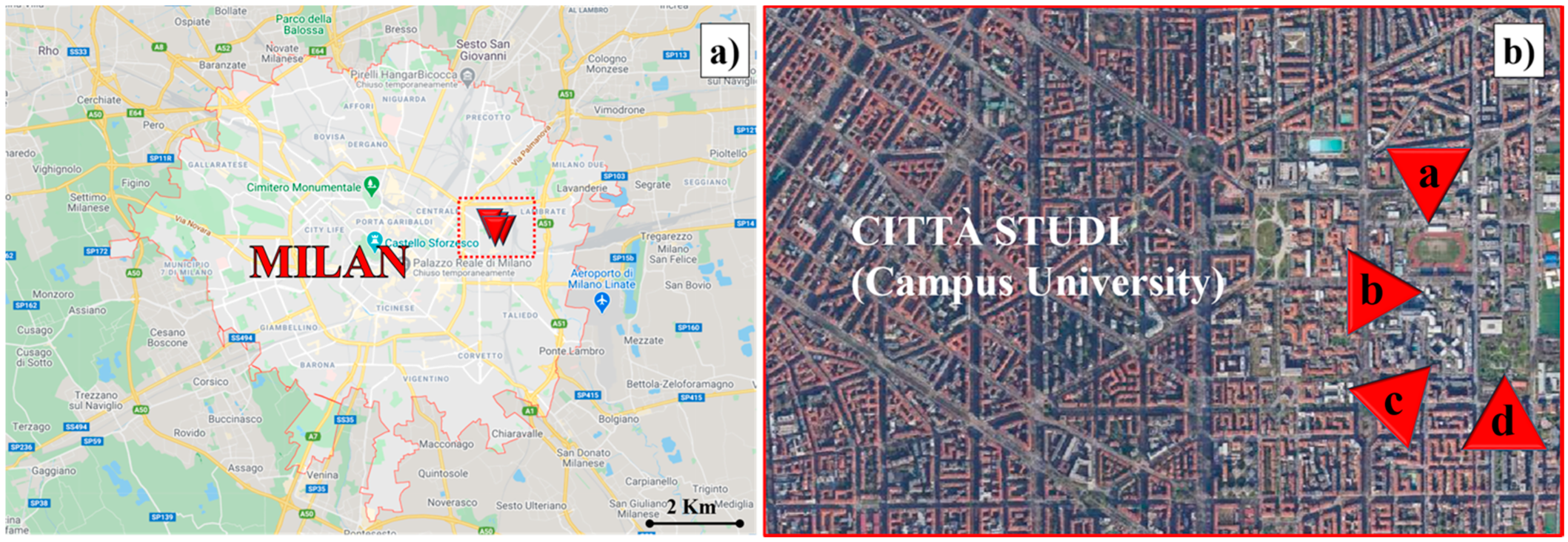
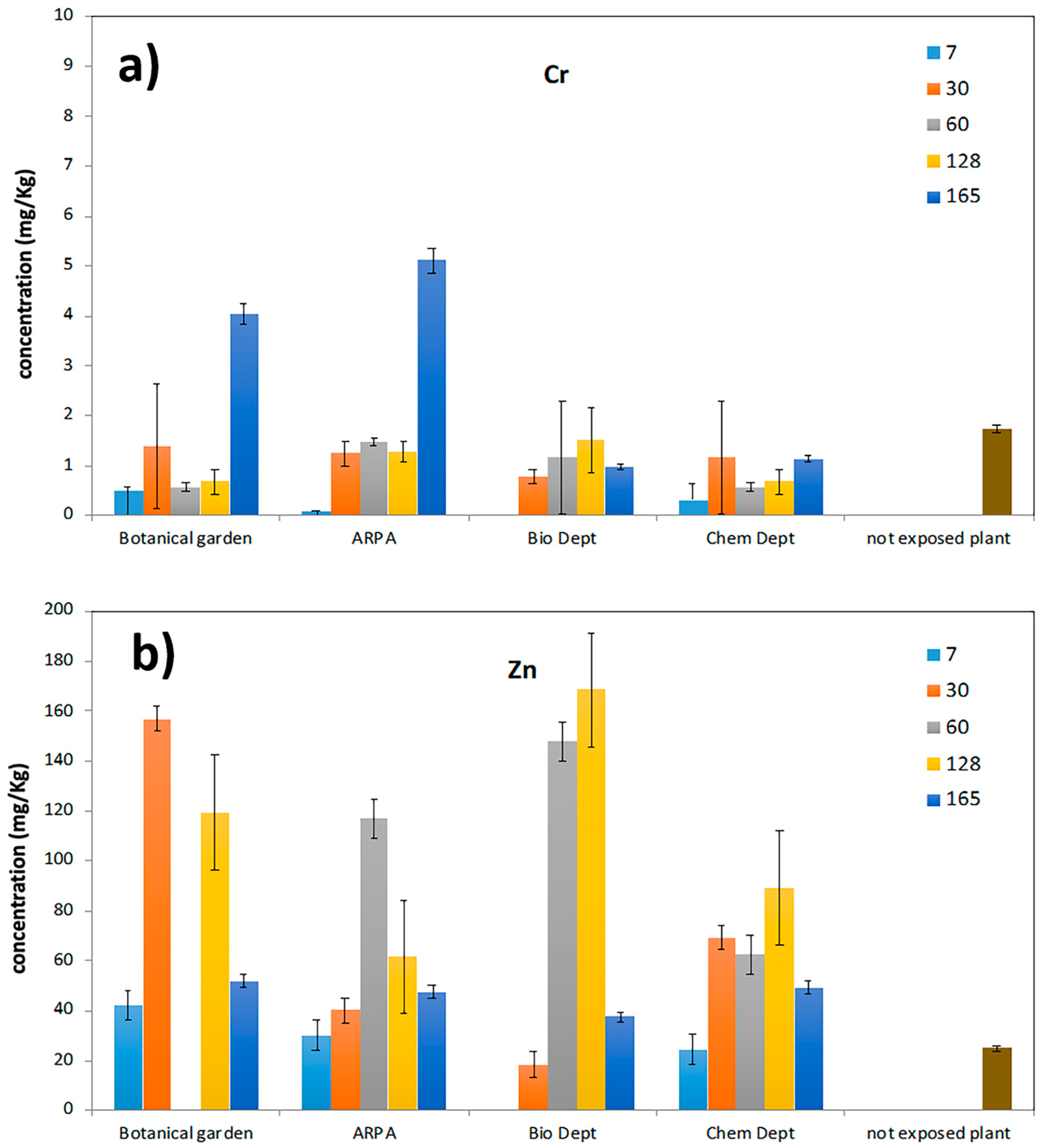
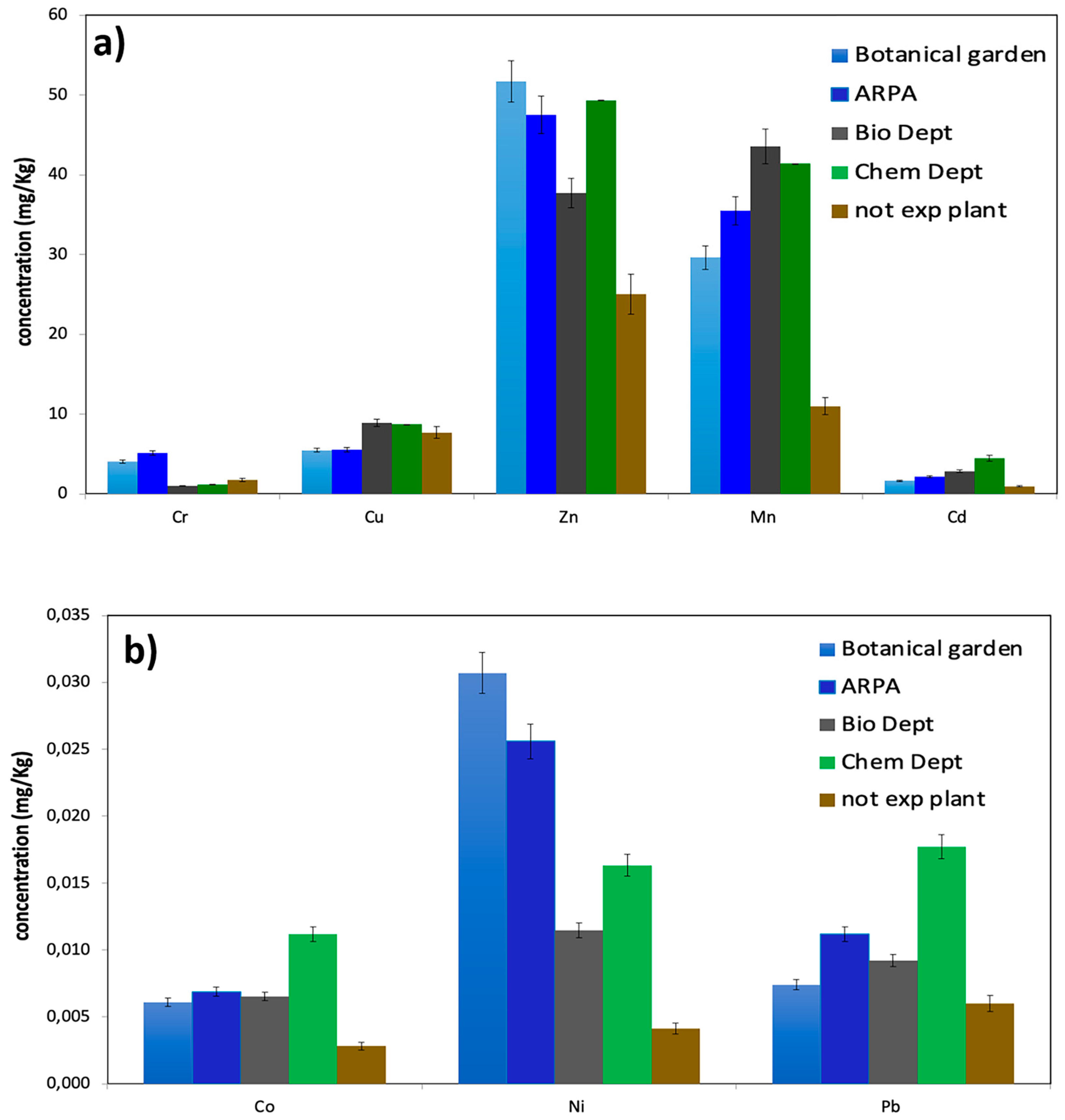
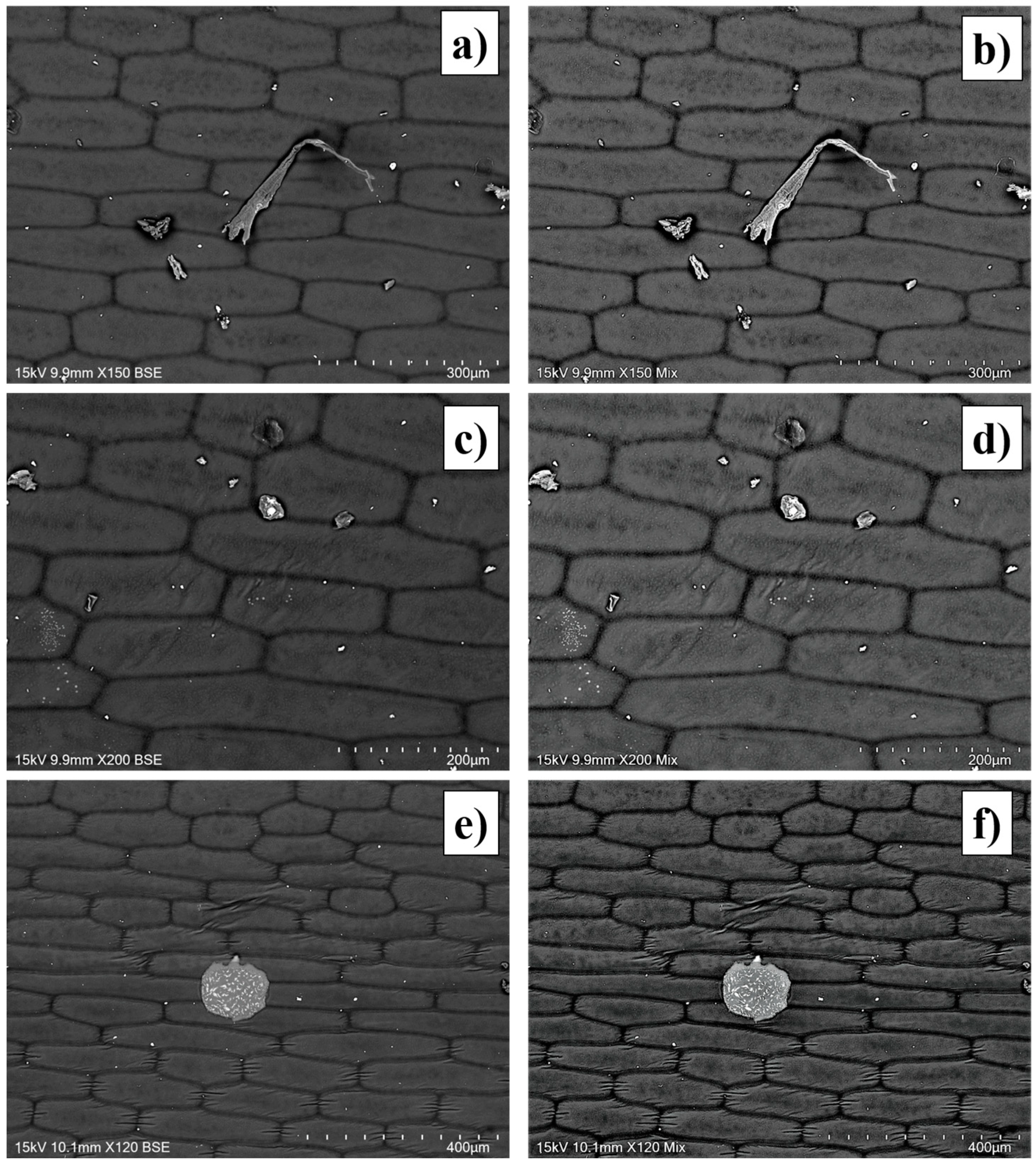

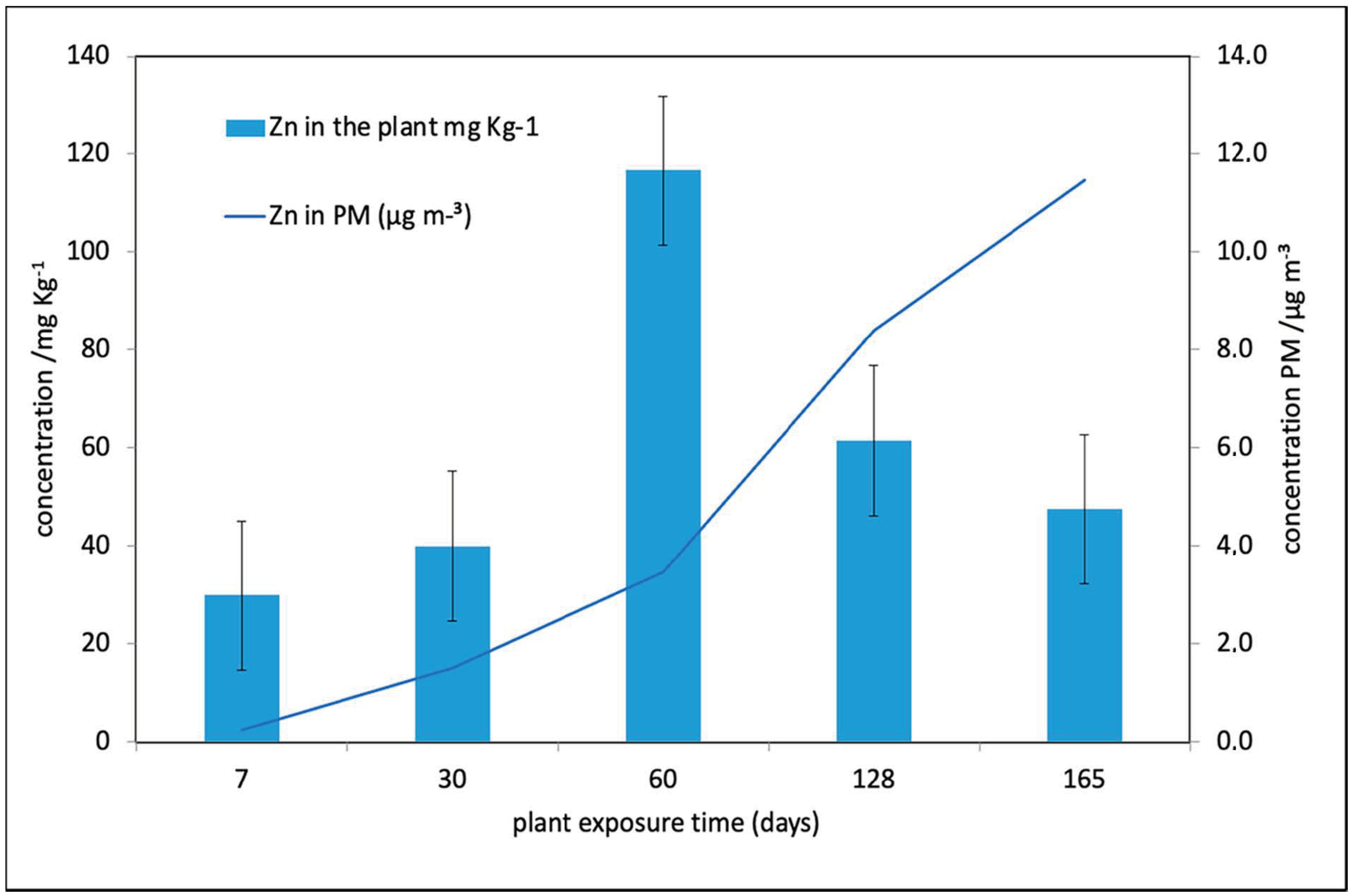
| Sampling Site | Site ID | Exposure Date | Collection Date and Exposure Duration | ||
|---|---|---|---|---|---|
| ARPA Regional Agency for the Environmental Protection | ARPA | July 2018 | September 2018—60 days | November 2018—128 days | December 2018—165 days |
| July 2018 | September 2018—60 days | November 2018—128 days | December 2018—165 days | ||
| October 2018 | - | November 2018—30 days | - | ||
| October 2018 | - | November 2018—30 days | - | ||
| Biosciences Department University of Milan | Bio Dept | July 2018 | September 2018—60 days | November 2018—128 days | December 2018—165 days |
| July 2018 | September 2018—60 days | November 2018—128 days | December 2018—165 days | ||
| October 2018 | - | November 2018—30 days | - | ||
| October 2018 | - | November 2018—30 days | - | ||
| Chemistry Department University of Milan | Chem Dept | July 2018 | September 2018—60 days | November 2018—128 days | December 2018—165 days |
| July 2018 | September 2018—60 days | November 2018—128 days | December 2018—165 days | ||
| October 2018 | - | November 2018—30 days | - | ||
| October 2018 | - | November 2018—30 days | - | ||
| Botanical Garden University of Milan | Botanical Garden | July 2018 | September 2018—60 days | November 2018—128 days | December 2018—165 days |
| July 2018 | September 2018—60 days | November 2018—128 days | December 2018—165 days | ||
| October 2018 | - | November 2018—30 days | - | ||
| October 2018 | - | November 2018—30 days | - | ||
Publisher’s Note: MDPI stays neutral with regard to jurisdictional claims in published maps and institutional affiliations. |
© 2021 by the authors. Licensee MDPI, Basel, Switzerland. This article is an open access article distributed under the terms and conditions of the Creative Commons Attribution (CC BY) license (https://creativecommons.org/licenses/by/4.0/).
Share and Cite
Fermo, P.; Masiero, S.; Rosa, M.; Labella, G.; Comite, V. Chlorophytum comosum: A Bio-Indicator for Assessing the Accumulation of Heavy Metals Present in The Aerosol Particulate Matter (PM). Appl. Sci. 2021, 11, 4348. https://doi.org/10.3390/app11104348
Fermo P, Masiero S, Rosa M, Labella G, Comite V. Chlorophytum comosum: A Bio-Indicator for Assessing the Accumulation of Heavy Metals Present in The Aerosol Particulate Matter (PM). Applied Sciences. 2021; 11(10):4348. https://doi.org/10.3390/app11104348
Chicago/Turabian StyleFermo, Paola, Simona Masiero, Mario Rosa, Giovanna Labella, and Valeria Comite. 2021. "Chlorophytum comosum: A Bio-Indicator for Assessing the Accumulation of Heavy Metals Present in The Aerosol Particulate Matter (PM)" Applied Sciences 11, no. 10: 4348. https://doi.org/10.3390/app11104348
APA StyleFermo, P., Masiero, S., Rosa, M., Labella, G., & Comite, V. (2021). Chlorophytum comosum: A Bio-Indicator for Assessing the Accumulation of Heavy Metals Present in The Aerosol Particulate Matter (PM). Applied Sciences, 11(10), 4348. https://doi.org/10.3390/app11104348








